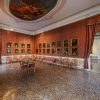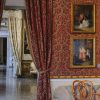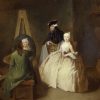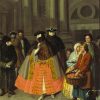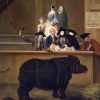The painting on the ceiling with Zephyr and Flora is the last painting by Giambattista Tiepolo present in the palace, although it was the first to be painted. It comes in fact from the rooms of Ca’ Pesaro and was done on the occasion of the marriage between Antonio Pesaro and Caterina Sagredo, celebrated in 1732. The subject, which was frequent in the Baroque era, alludes to the reawakening of nature (Flora) with the coming of spring, which is announced by a light, warm breeze (Zephyr). It augurs fecundity for the newlyweds.The colours are transparent and bright; virtuoso pieces like Flora’s iridescent drape or the crystalline texture of Zephyr’s wings alternate with sensuous flesh tones.
In contrast to Tiepolo’s imaginative art, along the walls you can view the whole of Pietro Longhi’s original production, which takes us into the daily life of 18th-century Venice, both the festive life of the carnival and the reserved life of the nobility who, for the first time here, open the doors of their palaces to indiscrete scrutiny, at least in a virtual sense. Pietro Longhi’s artistic career was long and complex and covered numerous artistic genres. After a not very brilliant career as an historical painter he converted to genre painting, more precisely to the painting of pastoral scenes. First he painted isolated figures of shepherds and peasant women, then he transferred them into rustic country interiors, where they are seen in attitudes of tender, joyful complicity, as in the painting called Polenta or the one called Furlana, a folk dance.
After these works dedicated to a merry Italian Arcadia, towards the mid-18th century Longhi’s investigative eye turned to the town, and he changed subject and style. It was in this field that he made his name. His new subjects were the members of Venetian patrician society, no longer shown in formal portraits like those on the lower floor, but portrayed as they went about their daily business: the Barber, the Morning Chocolate, or the Visit of the bauta (bauta is a masked carnival character) or The Moor’s Letter. It was the first time that the Venetian aristocracy had been shown, so to speak, in their dressing gowns, busy at their various pastimes. In describing this private world Pietro Longhi uses an extremely delicate technique based on soft colours and continuous tiny brushstrokes which enhance the effect of the elaborate fabrics.
The painter also follows the aristocratic couple outside their homes, where they are going not to take part in public ceremonies but to have fun at the Carnival. The places they stop at are the huckster’s or hawkers’ stands. Longhi portrays the noble Venetians with their faces masked so as to remain anonymous, just as Venetian Republican laws demanded. The attractions of the Carnival, which lasted all of three months, included exotic animals like lions, elephants and, in this case, a Rhinoceros. These were real curiosities for those times, and it was the patricians themselves who asked Longhi to immortalise them in paint.
The yellow lacquer furniture decorated with floral motifs and red curls was originally in a drawing-room in Palazzo Calbo Crotta. The rare tub sofa is particularly curious.
Throughout the Venetian carnival, which lasted a full three months, the various booths set up in the St. Mark’s area kept coming curious and various vendors: puppeteers, magicians, astrologers, charlatans, depicted by Pietro Longhi in many of the paintings on display here. Among the major attractions there were also exotic animals such as lions, elephants and, in this case, the Rhinoceros. For the carnival of 1751, after a highly successful European tour, there arrived in Venice a female Indian rhinoceros named Clara. The owner, Douwe Mout van der Meer, a captain of the Dutch East India Company, had brought her with him from Bengal, soon turning her into an attraction that toured all the major European cities up to 1758, the year of her death. As stated in the notice painted in trompe l’oeil to the right of the painting, this portrait of the rhinoceros was commissioned to the artist by Giovanni Grimaldi, who had a private menagerie with many exotic animals in his villa on the mainland. Longhi made a second painting nearly identical to Grimani’s for Girolamo Mocenigo, now in the National Gallery in London. It is undoubtedly one of Pietro Longhi’s masterpieces, who succeeded in documenting the curiosity awakened by this unusual arrival in the city, magically combining intimate and the mundane aspects by placing the animal in the fascinating atmosphere of the Venetian carnival, to which it adds a fresh touch of historical truth. At the center of the pyramidal composition, we find the commissioner of the painting himself (who was 23 years old at the time) next to his beautiful and unfortunate bride, Caterina Contarini, who was to die shortly after giving birth to their only daughter.
